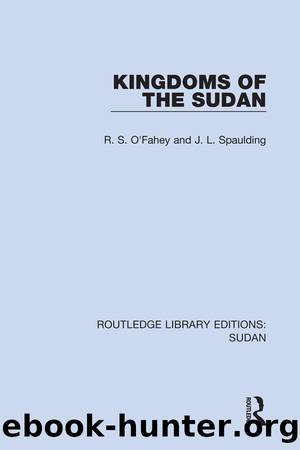Kingdoms of the Sudan by R.S. O'Fahey J.L. Spaulding

Author:R.S. O'Fahey, J.L. Spaulding [R.S. O'Fahey, J.L. Spaulding]
Language: eng
Format: epub
Tags: Social Science, Regional Studies
ISBN: 9781315451114
Google: qPMwDQAAQBAJ
Publisher: Routledge
Published: 2016-10-04T04:16:40+00:00
VIII
The rise of the Keira
The Keira sultan, IbrÄhÄ«m b. Muḥammad al-Ḥusayn, who was killed unsuccessfully defending his state in 1874, was only seven generations removed from SulaymÄn, the first historical Keira sultan, who, as is argued below, probably ruled about the middle of the seventeenth century. Concerning the Keira kings between SulaymÄn and Daali, âthe father of the Furâ, jadd al-FÅ«r, the traditions are very confused, but taking an average of the regnal lists we have, the period between them would appear to be about eight generations.1 This may suggest, although it cannot be proved, that a Fur or Keira kingdom existed in Jabal Marra as early as the fifteenth century and therefore was contemporary with the Tunjur empire in northern DÄr FÅ«r.
If this supposition is correct, then the traditions concerning the origins of the Keira state may be interpreted in the following manner. The Keira clan, who came from the Kunjara section of the Fur people, ruled a kingdom in Jabal Marra which formed part of the Tunjur empire, to whose ruling dynasty they may have been connected by dynastic marriage. Sometime after about 1580 (dâAnaniaâs reference) but before 1660 when the name Fur first appears in contemporary records, the Tunjur state collapsed and the Keira expanded rapidly to fill the vacuum.
The ambiguity of Aḥmad al-MaâqÅ«râs relationship to the Tunjur and Keira thus may conceal the fact that the two dynasties were related. It may not be too fanciful to note that the names Tunjur and Kunjara could form a singular/plural pair in Fur.2 Their Tunjur connexions were naturally soon forgotten by the Keira, particularly if they also arrogated to themselves traditions concerning immigrants from the Nile â the other aspect of the Aḥmad al-MaâqÅ«r cycle â which had originally belonged to the Tunjur. But the Tunjur connexion was not forgotten in Wadai, since the latter continued to pay to the Keira the tribute formerly paid to the Tunjur.3
This interpretation of the traditions, although admittedly speculative, would help to explain the shadowy nature of the pre-Sulaymanic Fur traditions, belonging as they do to a Fur tribal chiefdom, about which in the time of later imperial and Islamic splendour it was convenient to forget. It would also explain the apparently very rapid spread of Keira power under SulaymÄn and his immediate successors in the latter part of the seventeenth century. Heirs to an imperial tradition, they were expanding to take control of a Tunjur trading network and empire that had existed in the recent past.
Download
This site does not store any files on its server. We only index and link to content provided by other sites. Please contact the content providers to delete copyright contents if any and email us, we'll remove relevant links or contents immediately.
Man-made Catastrophes and Risk Information Concealment by Dmitry Chernov & Didier Sornette(5647)
The Revenge of Geography: What the Map Tells Us About Coming Conflicts and the Battle Against Fate by Kaplan Robert D(3961)
Zero Waste Home by Bea Johnson(3655)
In a Sunburned Country by Bill Bryson(3365)
COSMOS by Carl Sagan(3346)
Good by S. Walden(3345)
The Fate of Rome: Climate, Disease, and the End of an Empire (The Princeton History of the Ancient World) by Kyle Harper(2870)
Camino Island by John Grisham(2719)
A Wilder Time by William E. Glassley(2690)
Organic Mushroom Farming and Mycoremediation by Tradd Cotter(2565)
The Ogre by Doug Scott(2501)
Human Dynamics Research in Smart and Connected Communities by Shih-Lung Shaw & Daniel Sui(2431)
Energy Myths and Realities by Vaclav Smil(2380)
The Traveler's Gift by Andy Andrews(2299)
9781803241661-PYTHON FOR ARCGIS PRO by Unknown(2268)
Inside the Middle East by Avi Melamed(2230)
Birds of New Guinea by Pratt Thane K.; Beehler Bruce M.; Anderton John C(2175)
A History of Warfare by John Keegan(2104)
Ultimate Navigation Manual by Lyle Brotherton(2048)
